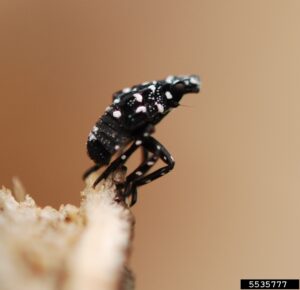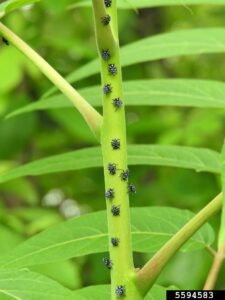By: Elizabeth Barnes, Purdue University
Reprinted here with permission.
Spotted lanternfly has now hatched in Indiana. As of the writing of this article, it has only been found in the southeastern corner of the state but there may be other populations we are not aware of (for full distribution in the United States see this map). Be on the lookout for small (~1/4th inch long) black insects with white spots (image 1). First instar nymphs tend to prefer to feed on the new growth of plants and may be found in large groups (image 2). In the spring, they are often found on grape, roses, tree of heaven, black walnut, butternut, and perennials but are capable of feeding on over 70 species of plants. Spotted lanternfly can kill grape vines and early research suggests they may make other plants more susceptible to stresses like disease and drought. If you think you’ve found a spotted lanternfly, take a picture and report it right away so that we can work to slow its spread (EDDMapS Website, Email: DEPP@dnr.in.gov, or 1-866 NO EXOTIC (1-866-663-9684)).
Image 1. This photo shows a closeup of a first instar spotted lanternfly. Note how the insect holds itself at an angle away from the plant when at rest. Photo by Lawrence Barringer, Pennsylvania Department of Agriculture.
Spotted Lanternfly ID and Look-a-LikesFirst through third instar spotted lanternfly nymphs have rounded bodies with long noses. Unlike adults, fourth instar spotted lanternfly are a nondescript black with white spots. They are commonly confused with ticks. However, where ticks hold their bodies tight to a surface, spotted lanternfly hold themselves up at an angle. Additionally, spotted lanternfly usually hop away when disturbed whereas ticks will crawl away.A Note About TicksTick season is ramping up and it’s important to know what to do if you find one. A wide range of ticks are common in Indiana including species that are known to transmit diseases like Lyme disease and Rocky Mountain Spotted Fever. Additionally, we are keeping an eye out for two new invasive ticks this year (Gulf coast tick and Asian long-horned tick). Please report them if you find any. If you spend time in tick habitat, using EPA approved repellants and performing a tick check when you get home can help protect you against ticks. The CDC suggests that you seek medical attention if you have been in tick habitat, recovered an attached tick, and develop symptoms of tick-borne diseases known to circulate in Indiana tick populations. To learn more about ticks including how to submit tick samples, check out tick INsiders.





